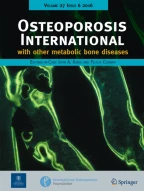379Accesses
124Citations
15 Altmetric
Abstract:
We conducted an efectiveness meta-analysis to determine the efficacy of fluoride therapy on bone loss, vertebral and nonvertebral fractures and side effects in postmenopausal women. A literature search was conducted on MEDLINE, Current Contents and the Cochrane Controlled Trial Registry. Two independent reviewers selected randomized controlled trials which met predetermined inclusion criteria. They independently extracted data using predetermined forms and assessed the methodologic quality of the trials using a validated scale. For dichotomous outcomes, the relative risk (RR) was calculated, and for continuous outcomes, the weighted mean difference (WMD) of percentage change from baseline was calculated. Where heterogeneity existed (determined by a chi-square test) a random effects model was used. Eleven studies (1429 subjects) met the inclusion criteria. The increase in lumbar spine bone mineral density (BMD) was found to be higher in the treatment group than in the control group with a WMD 8.1% (95% CI: 7.15, 9.09) after 2 years of treatment and 16.1% (95% CI: 14.65, 17.5) after 4 years. The RR for new vertebral fractures was not significant at 2 years [0.87 (95% CI: 0.51, 1.46)] or at 4 years [0.9 (95% CI: 0.71, 1.14)]. The RR for new nonvertebral fractures was not significant at 2 years [1.2 (95% CI: 0.68, 2.10)] but was increased at 4 years in the treated group [1.85 (95% CI: 1.36, 2.50)], especially if used at high doses and in a non-slow-release form. The RR for gastrointestinal side effects was not significant at 2 years [2.18 (95% CI: 0.86, 1.21)] but was increased at 4 years in the treated group [2.18 (95% CI: 1.69, 4.57)], especially if fluoride was used at high doses and in a non-slow-release form. The number of withdrawals and dropouts was not different between treated and control groups at 2 and 4 years. Thus, although fluoride has an ability to increase bone mineral density at the lumbar spine, it does not result in a reduction in vertebral fractures. Increasing the dose of fluoride increases the risk of nonvertebral fractures and gastrointestinal side effects without any effect on the vertebral fracture rate.
This is a preview of subscription content,log in via an institution to check access.
Access this article
Subscribe and save
- Starting from 10 chapters or articles per month
- Access and download chapters and articles from more than 300k books and 2,500 journals
- Cancel anytime
Buy Now
Price includes VAT (Japan)
Instant access to the full article PDF.
Similar content being viewed by others
Explore related subjects
Discover the latest articles, books and news in related subjects, suggested using machine learning.Author information
Authors and Affiliations
Clinical Epidemiology Unit, University of Ottawa, Ottawa Hospital, Ottawa, Ontario, , , , , , CA
D. Haguenauer, V. Welch, B. Shea & G. Wells
Department of Medicine, University of Ottawa, Ottawa Hospital, Ottawa, Ontario;, , , , , , CA
P. Tugwell
Department of Medicine, St Joseph”s Hospital, McMaster University, Hamilton, Ontario, Canada, , , , , , CA
J. D. Adachi
- D. Haguenauer
Search author on:PubMed Google Scholar
- V. Welch
Search author on:PubMed Google Scholar
- B. Shea
Search author on:PubMed Google Scholar
- P. Tugwell
Search author on:PubMed Google Scholar
- J. D. Adachi
Search author on:PubMed Google Scholar
- G. Wells
Search author on:PubMed Google Scholar
Additional information
Received: 23 February 2000 / Accepted: 23 February 2000
Rights and permissions
About this article
Cite this article
Haguenauer, D., Welch, V., Shea, B.et al. Fluoride for the Treatment of Postmenopausal Osteoporotic Fractures: A Meta-Analysis.Osteoporos Int11, 727–738 (2000). https://doi.org/10.1007/s001980070051
Issue date:
Share this article
Anyone you share the following link with will be able to read this content:
Sorry, a shareable link is not currently available for this article.
Provided by the Springer Nature SharedIt content-sharing initiative



